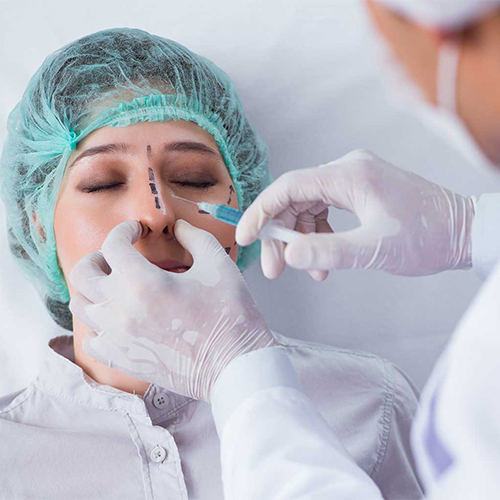Nasal Surgery for Normal Nasal Airflow
Any surgery that involves is performe inside or on the outside of the nose is called Nasal surgery.
Nasal obstruction results from anatomic and functional problems, which cause dysfunctional airflow in the upper airway. Therefore playing a vital role in OSA and snoring and prevent CPAP use. The cause of nasal airflow problems is also due to deviated nasal septum, nasal polyps, enlarged nasal turbinate, and swollen nasal mucosa. Due to allergies, narrowing or collapse of the nasal openings, other irritants, or a combination of all.
Conditions Treated With Reconstructive Nose Surgery
Usually, Reconstructive, cosmetic surgery, nasal surgery is carrie out to accomplish the following:
- Resolve breathing issues
- Repair nasal injuries
- Correct congenital or acquired deformities
- Change size or shape of the nose (cosmetic)
Issues Treated with Sinus Surgery Include
Obstructive sleep apnea (OSA)
It happens when a patient quits breathing during times of rest, generally because of blockage (hindrance) in the aviation route.
Types of Nasal Surgery
- Turbinate reduction
- Septoplasty
- Rhinosseptoplasty
- Rhinoplasty
About the Procedure
Although nasal surgeries vary from patient to patient, generally, nasal surgeries follow this process:
Hospital outpatient
Location options may include:
- Surgeon’s office-based surgical facility
- Hospital inpatient
- Outpatient surgery center
Learn more about preparing for your surgery.
Anesthetic Options for Nose Surgery may Include
- Local anesthesia
- General anesthesia
- The average duration of the nasal surgery is around two hours
- The recuperation period is usually up and around for a few days
- Patient typically return to school or sedentary work a week or so after surgery
- The surgeon provides guidelines to resume routine activities
Side effects of Nasal Surgery
Following are some of the possible short-term side effects of nasal surgery:
- A splint applied to the nose helps retain the new nose shape.
- Nasal packs or soft plastic splints are also place inside the nostrils, which stabilize the septum.
- After nose surgery, the face might feel puffy.
- There are chances that the patient’s nose may ache.
- The patient may experience swelling around the eyes, dull headaches, or bruising around the eyes.
- small amount of bleeding is also expect during the first few days.
- Small burst blood vessels appear as tiny red spots on the skin’s surface.
A Short Brief on After Effects of Nasal Surgery
- Healing from any surgical procedure takes time and is a gradual process.. The final results of nasal surgery take a year or more to appear.
- At the point when conventional open a medical procedure is performe on limited erupted nostrils, it causes little scars on the foundation of the nose. The injuries typically stay unnoticeable. Scarring is invisible when Rhinoplasty is performe from inside the nose.
Nasal Surgery Postoperative Instructions
Nasal Splints
Splints are two pieces of plastic that an ENT surgeon stitches inside the patient’s nose. Although they provide long-term results, they can cause temporary discomfort and difficulty in breathing through the nose.
Pain Control
ENT doctors prescribe pain killer medications after sinus surgery. If you avoid narcotics, you must feel free to use acetaminophen.
Bleeding
It is usual to experience slight bleeding after nasal surgery for a couple of days. You may dab your nose gently with a tissue but never blow your nose. The patient must avoid Advil, aspirin, NSAIDs (such as ibuprofen, Motrin, Aleve or naproxen) for approximately two weeks because they increase the risk of bleeding.
Nasal saline two sprays in each nostril four to five times a day for about two weeks. Nasal saline washes away all crusts, dried and clotted blood. Thus accelerating healing by cleaning the nose after surgery and maintaining a moist environment inside the nose.
Minimize physical activity for two weeks
Patients can resume routine activities after undergoing isolated nasal surgery. Regular walks reduce the risks of developing pneumonia or blood clots in the legs. However, patients must avoid strenuous exercise and activities because that shall increase swelling and cause bleeding.
PATIENT MUST NOTIFY THEIR ENT DOCTOR IMMEDIATELY IF SIGNIFICANT BLEEDING OCCURS!
What Are The Possible Complications Associate with Nasal Surgery?
Potential intricacies related with nasal medical procedure might incorporate, but are not limite to, the following:
- Infection
- Nosebleed
- Anesthesia problems
- Rhinoplasty complications
Possible Complications that are associated with Rhinoplasty
Possible complications that are associate with Rhinoplasty include, but are not just limited to, the following list:
- Sometimes, the patient may require a second nasal surgery to treat a minor deformity resulting from the initial Rhinoplasty.
- Like other surgical procedures, there is also a risk of infection or reaction to the anesthesia in nose surgery. Nosebleeds also occur after sinus surgery.
- Sometimes, small blood vessels can also burst, which may cause tiny red spots on the nose surface. These spots appear minute but can stay permanent if not treated timely.
- In the “open” procedure, there is this possibility of occurring scars on the base of the nose







Leave a Reply